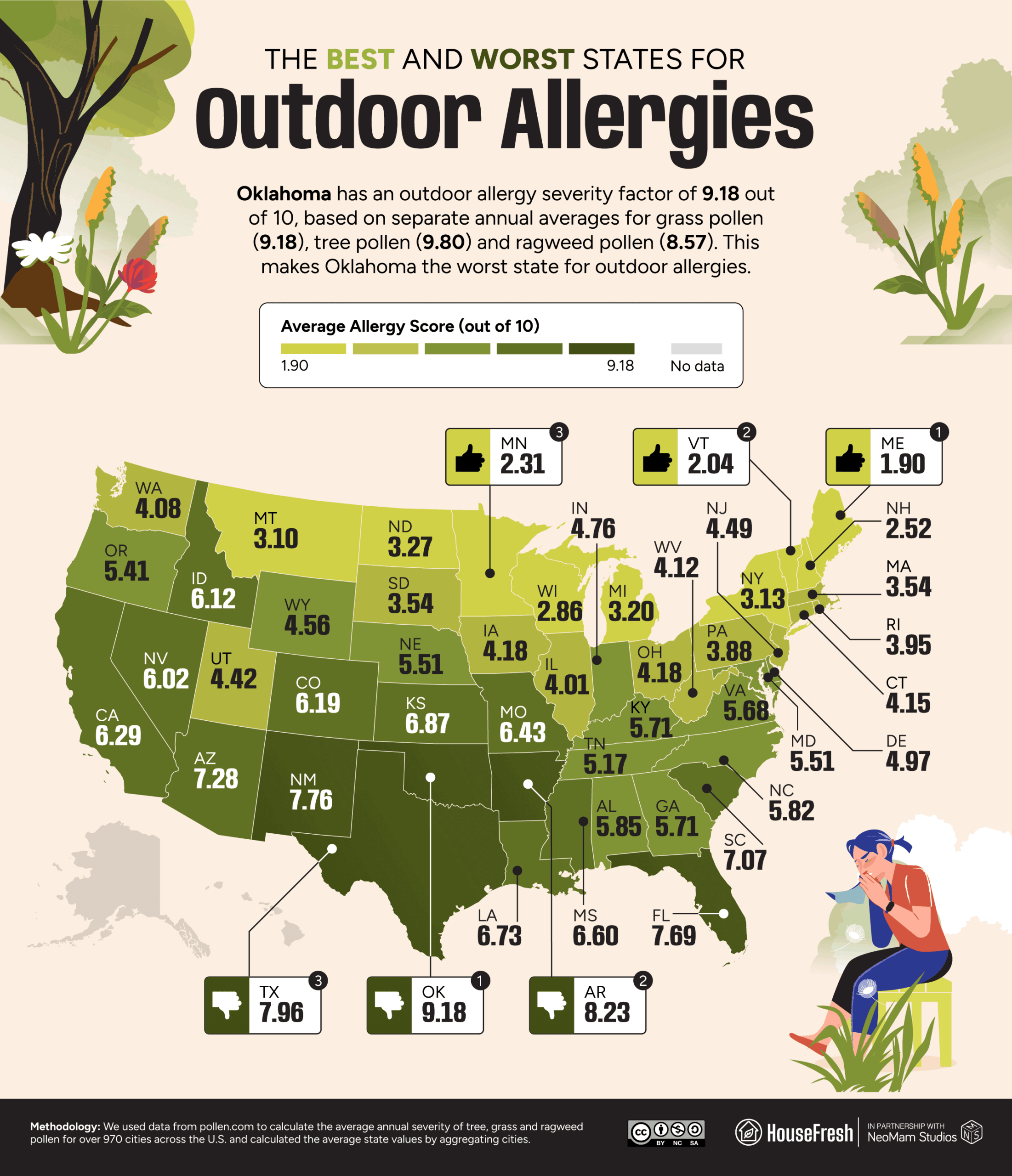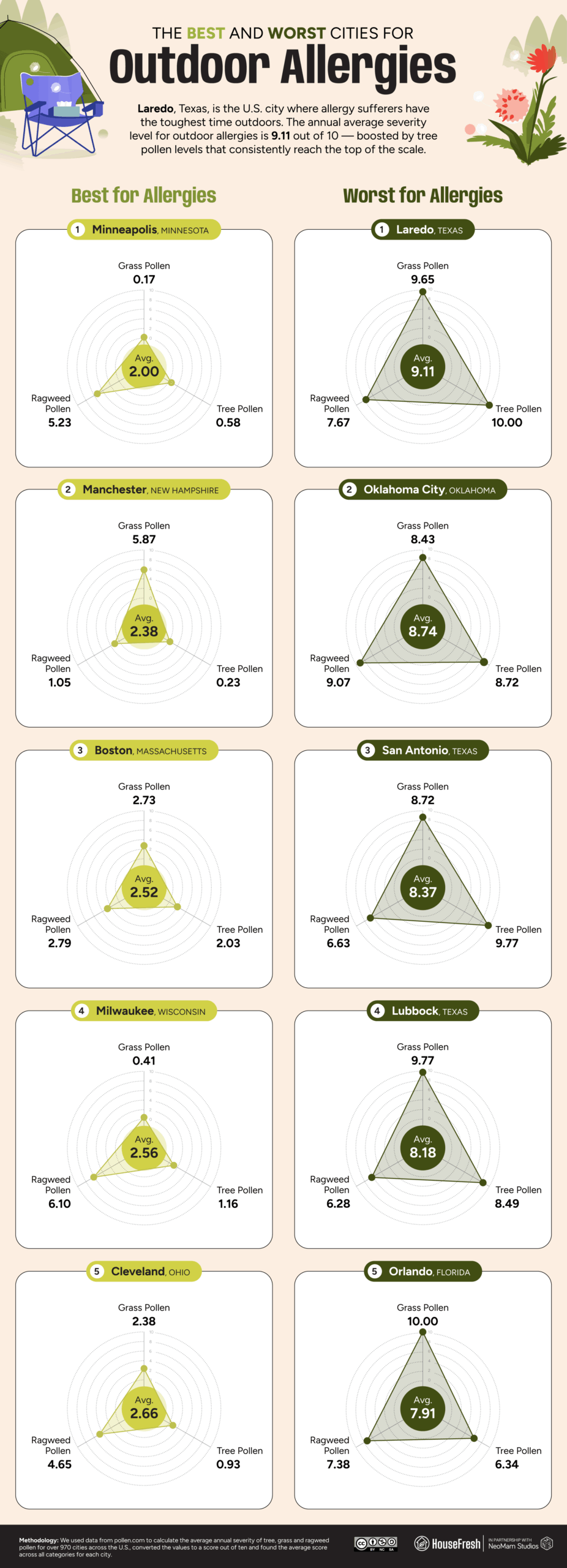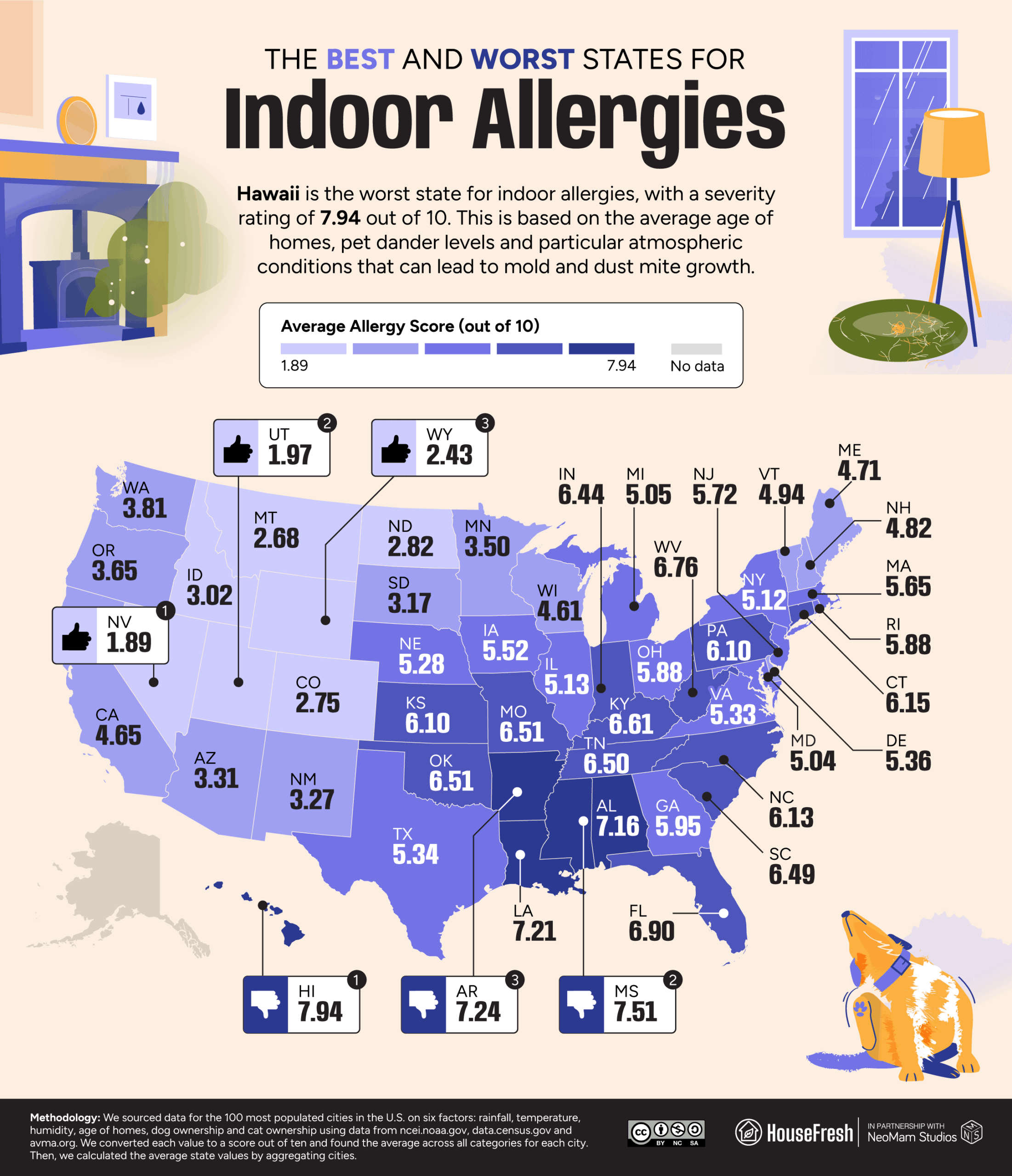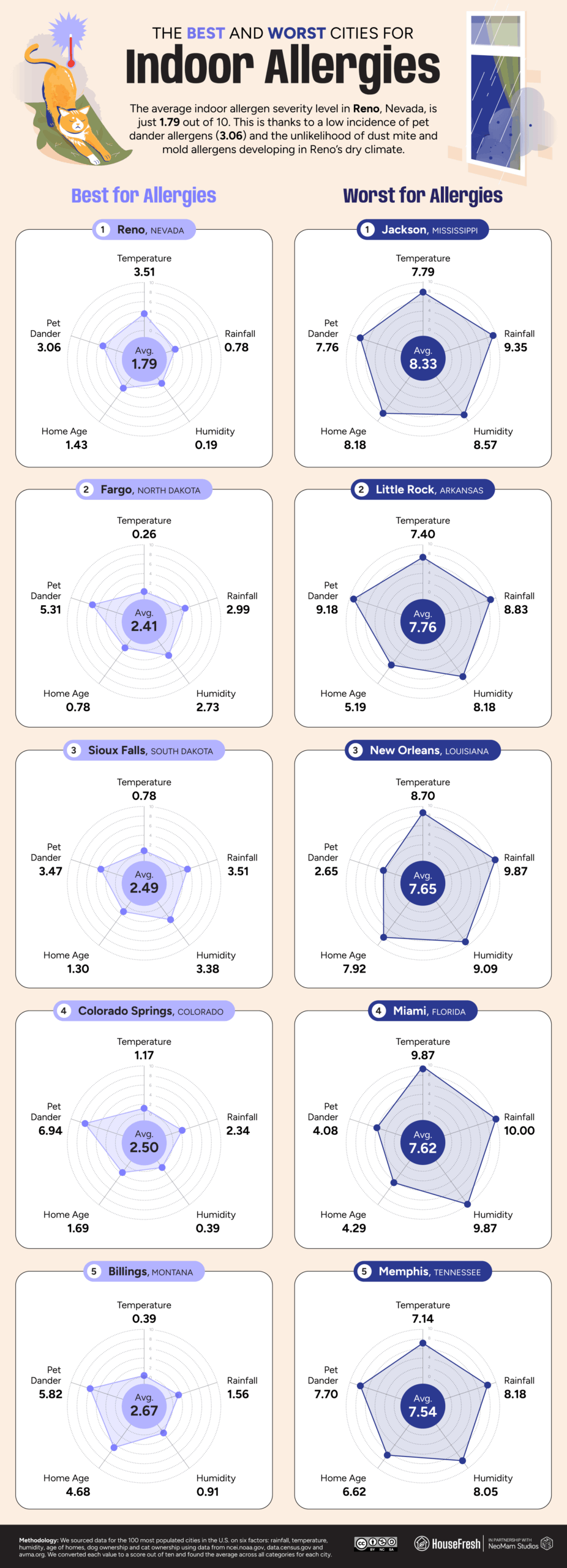Allergies are your body’s immune system reacting to a foreign substance, such as pet dander, pollen or shellfish, with clinical symptoms, such as coughing or swelling.
Over a quarter of U.S. children (27.2%) and nearly one-third of adults (31.8%) report having some kind of allergy, according to the National Center for Health Statistics. This equates to over 100 million people.
Seasonal allergies affect around five times more people than food allergies, yet they can be much harder to avoid. Both the seasons and the local climate affect the severity of indoor and outdoor allergies, such as animal dander and pollen. This leads to reactions that range from the irritating to the life-threatening: itchiness, sneezing or even asthma attacks.
There is no cure for allergies, but you can manage, prevent, or treat them. Since indoor and outdoor allergies respond to environmental conditions, one form of prevention is simply to be in the right place at the right time.
With that in mind, we have analyzed allergen data and statistics on local environmental conditions to identify the U.S. cities and states where indoor and outdoor allergies are most and least severe.
We analyzed data on indoor and outdoor allergens across the United States to determine where they are most prevalent, calculating a relative severity rating of 0 (low) to 10 (severe) and finding the average score across allergen types in each location.
For outdoor allergens, we used data from the pollen.com website to calculate the average annual severity of tree, grass, and ragweed pollen for over 970 cities across the U.S. and calculated the average values by state by aggregating cities.
For the indoor rankings, we found data for the 100 most populated cities in the U.S. on six factors: rainfall, temperature, humidity, age of homes, dog ownership and cat ownership.
Key findings
- Hawaii is the worst state for indoor allergies, with an average severity rating of 7.94 out of 10 across five indoor allergy variables.
- Laredo, Texas, is the worst city for outdoor allergies (9.11), whereas Jackson, Mississippi, is the worst city for indoor allergies (8.33).
- Oklahoma is the worst state for outdoor allergies, with a severity rating of 9.18 out of 10.
- Reno, Nevada, is the best city for indoor allergies, with a severity rating of just 1.79 — significantly lower than any other major city.
- Texas has severe outdoor allergy ratings (10/10) for both grass and tree pollen.
- Climate change is leading to greater amounts of pollen in the atmosphere.
Southern states and cities suffer from the most severe outdoor allergies
Oklahoma is worst overall, but Texas is worst for grass and tree pollen.
First, we identified the states and cities with the highest and lowest outdoor allergy risks. We found the highest concentrations are in southern and particularly south-central states.
Oklahoma has the worst average severity (9.18) based on grass pollen levels of 9.18, tree pollen at 9.80 and ragweed pollen at 8.57. However, people are allergic to different types of pollen, and it’s worth noting that Texas has worse levels of grass and tree pollen (both with a severity rating of 10, i.e., the worst in the U.S.). Only its low ragweed pollen count (3.88) puts Texas’s overall severity rating lower than those of Oklahoma and Arkansas.

Why the South? Rising levels of carbon dioxide lead plants to produce pollen while warming the climate. A warming climate leads to earlier, longer and more intense pollen seasons. So-called “seasonal” allergies now stretch to fill the whole calendar year in some locations — particularly in the Southern “pollen belt,” where it was warmer to start with and where strong winds circulate more pollen in the air and for longer.
“We know that climate change is leading to greater amounts of pollen in the atmosphere. It’s changing the seasonality of the pollen. It’s changing the types of pollen that we’re exposed to.”
– Paul Beggs
Environmental health scientist, Macquarie University in Sydney
The worst cities for outdoor allergies follow this same pattern, with three Texas cities (Laredo, San Antonio and Lubbock) among the top five.

Ragweed tends to prosper on land that’s been developed by humans, which may be one reason that ragweed pollen levels are around twice the average Texas level in these cities. One study found that ragweed pollen could be seven times higher in a city that’s 3.6 degrees warmer and has 30% more carbon dioxide than nearby rural areas — a common occurrence due to the urban heat island effect.
To find out what type(s) of pollen you are allergic to, you can take a doctor’s test or follow this quiz from Kleenex.
Hawaii and Mississippi have the worst indoor allergies
Jackson, Miss., is the worst city for pet dander and dust; Reno gets off lightly.
Indoor allergens include pet dander, dust and mold. Pet dander is the dead skin cells shed by furred or feathered pets, which are light enough to become airborne and cause irritation, so we factored local pet ownership rates into our severity rating. We also factored in average temperature, rainfall, humidity and the age of homes since these are variables that can intensify the presence and effects of dust mites and mold spores.
With their humid climates and higher-than-average pet ownership rates, Hawaii and Mississippi are the worst states for indoor allergies, with an average severity rating of 7.94 and 7.51 out of ten, respectively.

The Hawaiʻi State Department of Health notes that dust mites and mold can trigger severe asthma attacks, and 104,400 (9%) local adults and 30,000 (10%) children suffer from asthma in Hawaii. Among Native Hawaiians, asthma affects 15% of adults.
Alongside Mississippi, the hot southern states of Arkansas, Louisiana and Alabama are among the five worst places for indoor allergies. Temperatures may be high to the west in Arizona and California, but the southwest is experiencing a 25-year megadrought, with the soil now drier than at any time over the past 1,200 years. Although a side effect of this ongoing disaster may be to reduce the chance of specific indoor allergens, the drought blights the air through the increased incidence and severity of wildfires.

The city with the worst indoor allergies is Jackson, Mississippi, with an average severity of 8.33 out of ten based on high scores across all categories. While it may be hotter, rainier and more humid in New Orleans, the relatively low pet ownership rates here keep the average overall severity score at 7.65.
Reno, Nevada, is the best city for indoor allergies, with a severity rating of just 1.79 out of ten — significantly lower than any other major city. That might be a good reason to stay inside since Reno’s outdoor allergens are far more prevalent, and Reno has the fastest-expanding allergy season of any major city.
Find the allergy severity of any state or major city
But note that sometimes going somewhere new can be enough to trigger an allergy.
As the example of Reno — with a very low indoor allergy rating but outdoor severity of 5.33 — shows, no area is completely spared the effects of common allergens. But forewarned is forearmed, and you can check the full breakdown of each state and major city’s severity ratings overall and for each variable using our interactive chart.
Do note that moving to escape allergens may expose you to unfamiliar ones, and even if you stay in the same place, you may begin to suffer from new allergies.
“If you move to a new area, you may be impacted by new types of vegetation that grow in that environment. For some people who are experiencing new onset allergies, it is because changes in temperature and precipitation patterns allow plants and trees to grow in places they didn’t before.”
Dr. Neelu Tummala, a clinical assistant professor of otolaryngology at NYU Langone Health
As such, efforts to identify the allergens that affect you, reduce your exposure to them and prepare to remedy reactions as they occur may be the best way to minimize the irritation and even danger of indoor and outdoor allergies.
- Consider getting an air purifier with a high-quality particle filter and good air cleaning performance at quiet fan speeds, so you can run it inside your home 24/7. Check out our top picks for tackling airborne allergens.
- Close doors and windows when high pollen counts are forecasted, and don’t hang laundry outside to prevent bringing pollen back indoors.
- Avoid going outside when someone is mowing the lawn or trimming hedges and trees.
- Avoid using a dry cloth or feather duster — opt for a microfiber cloth or a damp rag instead, as it will help trap most dust without recirculating it into the air.
- Hoover carpets, upholstered furniture and curtains regularly with a HEPA filtered vacuum cleaner.
- Hot wash your bedding once a week and once dry, give it 10 minutes on high heat in a tumble dryer to eliminate dust mites.
- Regularly brush your pet to reduce the dander in their fur before it is released into the air.
- Try to create pet-free zones around your home (even if just your bedroom!) so you can reduce your contact hours with dander.
- To reduce your exposure to mold, keep your home dry by fixing leaks, venting your clothes dryer to the outside, and using insulation and storm windows.
Methodology
To identify the U.S. states and cities that are best and worst for people with allergies, we analyzed a series of metrics for outdoor and indoor allergens, respectively.
For the outdoor rankings, we sourced data for three allergens (tree, grass, ragweed) from the pollen.com website. We calculated the average annual severity of these allergens for over 970 cities across the U.S. and calculated the average values by state by aggregating cities.
For the indoor rankings, we considered six factors for all states and the top 100 most populated cities in the U.S.:
- Average annual rainfall (ncei.noaa.gov/)
- Average annual temperature (ncei.noaa.gov/)
- % of humid days (housefresh.com/the-most-humid-cities-in-the-world/)
- Median age of homes (data.census.gov)
- % of households with dogs (avma.org)
- % of households with cats (avma.org)
Dust mites and mold allergens thrive in warm, wet, humid climates. Hence, rainfall, temperature and humidity were considered as key factors that can promote mold and dust mite growth without intervention. Similarly, older homes are typically worse for mold owing to poor ventilation and insulation.
Dog and cat ownership rates were considered as indicators for the prevalence of another key indoor allergen: pet dander.
The final outdoor/indoor index scores were created by assigning values for each individual factor based on percentiles, assigning 10 to the highest value (worst score, relative to U.S. allergen levels). The further down the factor is located in the percentile distribution, the closer its assigned value is to 0 (best score). Then, to obtain an overall score, we calculated the average score across all factors for each ranking (i.e., the average score across all indoor allergen factors).
The data is correct as of June 2025.





